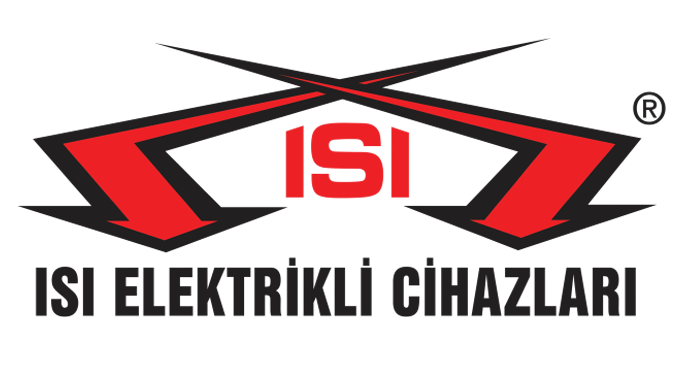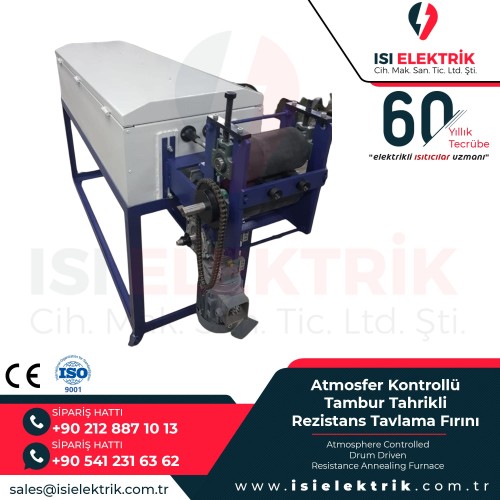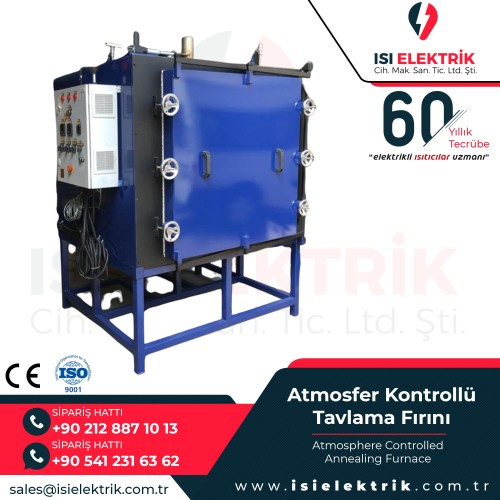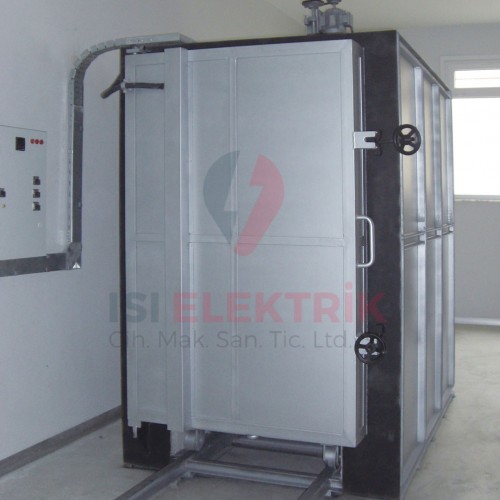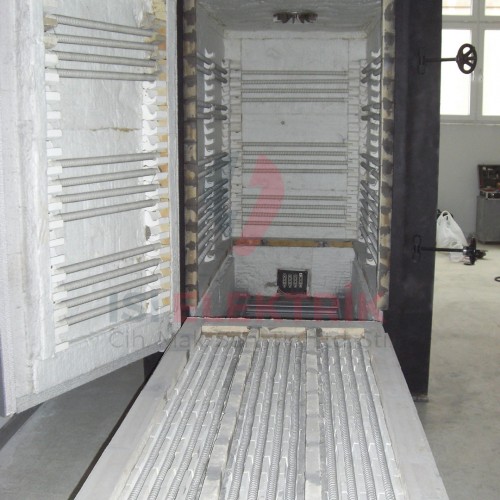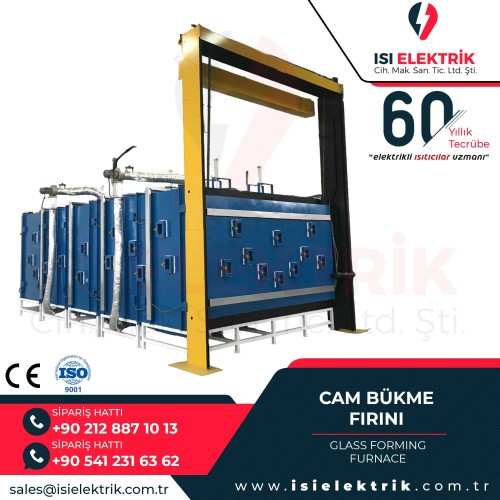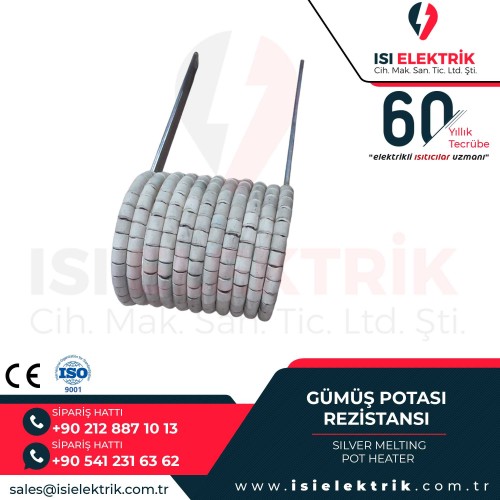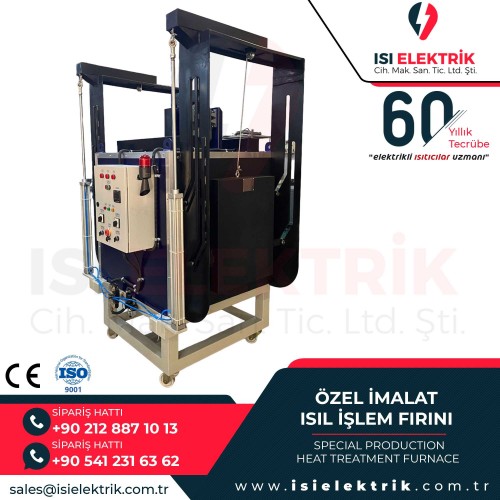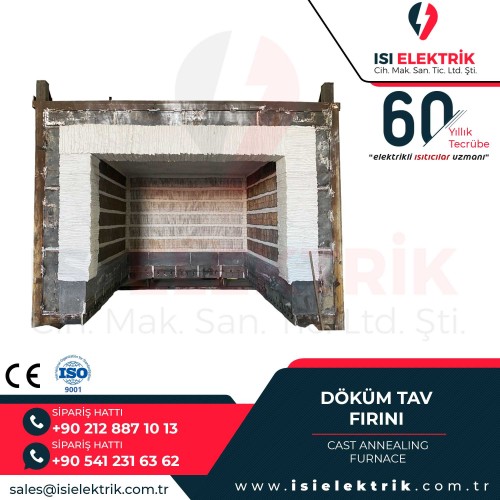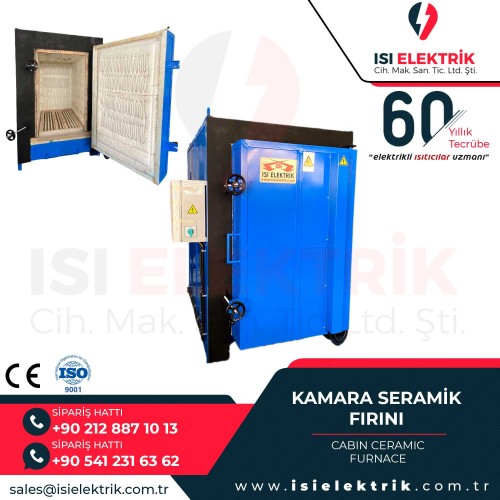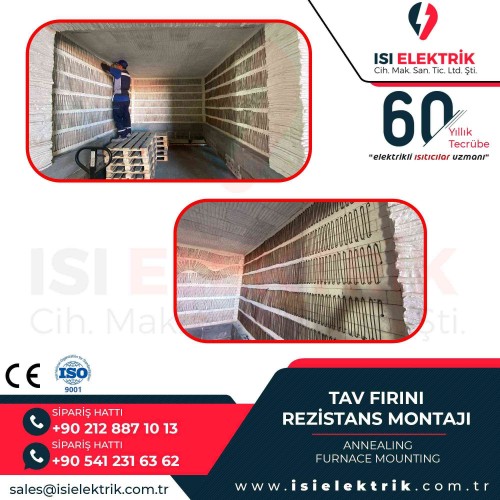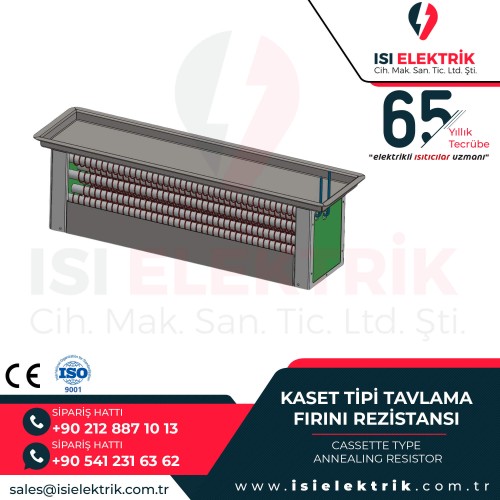Tempering Furnaces
Tempering furnaces are highly specialized furnaces used to heat various materials to very high temperatures; to alter hardness and strength properties differently. With this application, internal stresses are relieved, thus ensuring a more homogeneous structure of the material. These furnaces are predominantly used in the steel production sector.
Tempering Furnace
A tempering furnace is a type of industrial oven used to perform thermal processes on metal and other materials. The tempering process is applied to change various properties of metal parts, including altering, hardening, softening, relieving stresses, or achieving other desired characteristics.
What Are the Types of Annealing Furnaces?
There are different types of annealing furnaces used in the annealing process. These furnaces are categorized based on their application areas and processing requirements. Generally, annealing furnaces are divided into two main types: batch annealing furnaces and continuous annealing furnaces. These furnace types stand out with their customized designs tailored to material properties and processing needs.
Batch Annealing Furnaces: Batch annealing furnaces are systems where one or more coils are placed on a fixed base inside the heating chamber for a specific process duration. These types of furnaces are typically preferred for smaller-scale productions. Since the base of the furnace is stationary, materials remain in the same position throughout the process, ensuring uniform heating. The coils or other materials are kept in the heating chamber for a set period and are removed after the process is complete.
Continuous Annealing Furnaces: Continuous annealing furnaces, on the other hand, are suitable for larger-scale operations and continuous production environments. In these furnaces, materials are heated as they move on a conveyor or rotate within a chamber. During the process, the materials are subjected to gradual heating while progressing through the furnace. Coils undergo unwinding, and rewinding is performed as the material moves through the furnace. This design allows for the efficient processing of large quantities of material in a short time.
Annealing Duration and Heating Methods: The duration of the annealing process can vary depending on the type of material, process requirements, and coil dimensions. The process time typically starts from 15 minutes and can last for several hours. Annealing furnaces generally use natural gas as the primary heating source. Heat is circulated around the annealed material, and a fan is employed to ensure even distribution of heat. This ensures that the materials are exposed to consistent temperatures throughout the annealing process.
Features of Modern Annealing Furnaces: Modern annealing furnaces provide advanced features thanks to technological advancements. They allow for precise control of natural gas sources, monitoring and analyzing heating chamber conditions, and more. Additionally, these furnaces are equipped with fully computer-controlled systems. This enables complete monitoring, control, and optimization of all processes. Modern annealing furnaces improve production efficiency while also helping to save energy.
Advantages: The incorporation of modern technologies into annealing furnaces enables production processes to be managed more reliably, efficiently, and flexibly. These furnaces offer customizable processing options for different material types, providing businesses with a wide range of applications. The precise control of furnace conditions during the thermal process ensures high-quality results.
In conclusion, the variety of annealing furnaces ensures the flexibility and quality needed in production processes. Whether you are engaged in batch or continuous production, you can efficiently process your materials and enhance production quality with annealing furnaces. For more information and to select the right annealing furnace for your business, contact us today.
Advantages of Annealing Furnaces
Annealing furnaces provide several advantages. Here are some of the key benefits:
- Softening of Metals: Annealing softens materials, enhancing their machinability. This is especially useful for shaping hard metals like steel.
- Reduction of Internal Stresses: The annealing process reduces internal stresses formed during manufacturing, minimizing the risk of cracks or deformations.
- Dimensional Stability: Annealing helps metals achieve dimensional stability, which is critical for precise manufacturing processes.
- Improved Mechanical and Electrical Properties: The process enhances the durability of materials while also improving their electrical conductivity, making it ideal for components in electrical and industrial applications.
- Variety of Annealing Processes: Annealing furnaces can perform various heat treatments, including diffusion annealing, spheroidizing annealing, soft annealing, normalization, isothermal annealing, stress-relief annealing, recrystallization annealing, and ferritization, depending on the application requirements.
Processes Performed in Annealing Furnaces
Annealing furnaces are capable of conducting various processes to enhance the properties of metals used across industries:
- Diffusion Annealing: Ensures a homogeneous structure in metals, often used in alloyed steels.
- Spheroidizing Annealing: Improves the machinability of steel and is typically used before cold forming.
- Soft Annealing: Softens the material for easier machining, commonly used before machining operations.
- Normalization: A process to ensure homogeneity in the internal structure of metals.
- Isothermal Annealing: A specialized process to achieve high strength and durability in materials.
- Stress-Relief Annealing: Reduces internal stresses formed during manufacturing, preventing material cracking.
- Recrystallization Annealing: Removes structural deformations caused by cold forming, restoring the material to a new structure.
- Ferritization: Controls the carbon content in steel, enhancing thermal resistance, and is particularly useful for heat-resistant applications.
Annealing processes enhance the quality and workability of metals, optimizing production processes. If you are interested in purchasing or ordering an annealing furnace, contact us today to learn more and consult our expert team. Improve your production efficiency and achieve high-quality results with annealing furnaces.
Technical Specifications of Tempering Furnaces
- Power Range: Can range from 1 kW to 1000 kW.
- Voltage: Can have a voltage range from 12 Volts to 480 Volts.
- Temperature Resistance: Can withstand temperatures from 100°C to 1200°C.
- Material Options: Nickel-chromium, stainless steel, iron-chromium-aluminum, or similar durable materials can be used.
- Diameter Range: Can vary from 6 mm to 25 mm.
- Length: Can have a length range from 500 mm to 3000 mm.
- Connection Types: Nutted, bolted, or different connection types can be used.
- Thermocouple Types: J, K, T, E, or other thermocouple types can be preferred.
- Heating Element Type: Various heating element types such as wire-wound, mica-band, or ceramic-insulated can be found.
- Cooling Method: Air-cooled or water-cooled options can be preferred.
- Protection Class: IP65 or higher protection classes can be preferred.
- Mounting Type: Flanged, bolted, or different mounting types can be used.
Applications of Tempering Furnaces
- Metal Processing Industry: Tempering furnaces are widely used in the metal processing industry for processes such as hardening, annealing, normalizing, and modifying properties of metal parts.
- Automotive Industry: In the automotive sector, tempering furnaces are used for hardening and shaping engine parts, transmission components, axles, and other metal parts.
- Aerospace Industry: In the aerospace industry, tempering furnaces are used for hardening and enhancing the durability of engine parts, propellers, fuselage parts, and other critical components.
- Machine Manufacturing: In the machine manufacturing industry, tempering furnaces are needed for hardening and increasing the durability of gears, shafts, bearings, and other metal parts.
- Energy Sector: In the energy sector, tempering furnaces are used to enhance the durability of pipelines, valves, turbine parts, and other energy equipment.
- Mold Industry: In the mold industry, tempering furnaces are used for hardening, shaping, and increasing the durability of casting molds.
- Medical and Healthcare Industry: In the medical and healthcare industry, tempering furnaces are required for the thermal processing of metal parts used in the production of surgical instruments, implants, and other medical devices.
Advantages of Heater for Tempering Furnace
- High Precision: Heaters offer high precision in temperature control. This ensures that processed metal parts meet the desired specifications and enhances quality.
- Flexibility: Heater for tempering furnaces provides a flexible solution for processing metal parts of different shapes and sizes, accommodating various industrial applications.
- Controlled Cooling: Tempering furnaces not only heat but also allow controlled cooling. This helps achieve the desired hardness and durability of metal parts.
- Environmentally Friendly: With energy efficiency and controlled processing processes, heaters for tempering furnaces are environmentally friendly. They reduce environmental impact with lower energy consumption and waste production.
- Production Continuity: Tempering furnaces ensure continuous production continuity. With low failure risk and high performance, they offer uninterrupted production capability.
- Heat Distribution: Heaters provide homogeneous heat distribution within the furnace. This ensures that every point of the processed metal parts is heated equally, enhancing product quality.
Technical Details to Consider When Choosing Heater for Tempering Furnace
- Heat Distribution: The heat distribution provided by the heater should be homogeneous. Even heat distribution enables better cooking and tempering of products inside the furnace.
- Energy Efficiency: Choosing an efficient heater can reduce energy consumption and lower operating costs. Heaters with high efficiency can provide the same performance with less energy consumption.
- Protective Coating or Insulation: It is important for the outer surface of the heater to be coated with an appropriate protective coating or insulated. This helps protect parts in contact with electricity.
- Proper Connections: The heater should have suitable terminals or connection points for easy connection to the furnace circuit. Proper connections enhance electrical circuit safety and performance.
- Temperature Control and Balancing: The heater should have an appropriate balancing system to control the temperature inside the furnace. This is important for maintaining the desired temperature range.
- Proper Sizing: The heater should be of appropriate size to fit inside the furnace. It should be compatible with the internal volume and configuration of the furnace.
- Compliance with Safety Standards: It is important for the heater to comply with international safety standards. This is crucial for electrical safety and user protection.
Features of Annealing Furnaces That Ensure High Thermal Efficiency
Annealing furnaces are critical equipment in industrial production processes, offering energy savings and high efficiency. Equipped with modern technologies, these furnaces provide high thermal efficiency, reducing production costs and minimizing environmental impact. Below are the key features of annealing furnaces that ensure high thermal efficiency:
- Optimized Heat Distribution: Annealing furnaces are designed to distribute heat evenly. Homogeneous heat distribution within the furnace ensures that all materials are exposed to the same temperature, enhancing product quality while minimizing energy loss.
- Low Thermal Loss: The insulation materials and heat-resistant structures used in annealing furnaces minimize thermal losses. Heat is directed efficiently toward the material being processed, significantly improving energy efficiency.
- Energy Recovery Systems: Modern annealing furnaces recover and reuse waste heat generated during the process. These energy recovery systems save energy and reduce the carbon footprint.
- Rapid Heating and Cooling: Annealing furnaces can quickly reach the desired temperature and cool down rapidly when needed. This feature saves time and energy during production processes.
- Temperature Control and Stability: Annealing furnaces are equipped with thermocouples and temperature sensors for precise control. These systems respond quickly to temperature changes, maintaining a stable temperature throughout the process and preventing energy waste.
- High-Temperature Capacity: The materials used in annealing furnaces are resistant to high temperatures. This ensures the furnace’s longevity and consistent high performance.
- Advanced Insulation Technology: Modern annealing furnaces utilize advanced insulation technologies to minimize heat loss and maximize energy efficiency. Retaining heat within the furnace reduces process times.
- Durability and Longevity: Annealing furnaces are constructed from high-quality materials and can operate efficiently for many years with regular maintenance. This durability reduces operational costs and energy consumption.
These high thermal efficiency features of annealing furnaces provide significant advantages in terms of cost and environmental impact during production processes. For more information and to select an annealing furnace tailored to your needs, feel free to contact us.
Energy Saving with Annealing Furnaces
Annealing furnaces play a vital role in industrial processes, not only ensuring precise thermal treatment but also promoting significant energy savings. Through advanced technologies and efficient designs, these furnaces optimize energy consumption, reduce operating costs, and contribute to a more sustainable production process. Below are the key ways annealing furnaces enable energy savings:
- Advanced Insulation Materials: Modern annealing furnaces are equipped with high-quality insulation materials that minimize heat loss. This ensures that the heat generated is retained within the furnace, reducing the need for additional energy to maintain the desired temperature.
- Efficient Heat Distribution: Uniform heat distribution within the furnace allows for consistent processing of materials. This reduces the energy required to reheat certain sections, optimizing the overall energy consumption during the annealing process.
- Energy Recovery Systems: Many modern annealing furnaces include systems that capture and reuse waste heat. This recovered energy can be redirected to preheat incoming materials or support other parts of the production process, significantly lowering overall energy usage.
- Precise Temperature Control: With advanced temperature control systems, annealing furnaces can maintain stable operating conditions. This prevents energy wastage due to overheating or overcooling, ensuring optimal energy efficiency.
- Quick Heating and Cooling Cycles: Rapid heating and cooling capabilities allow annealing furnaces to reach operational temperatures quickly and reduce idle time. Shorter processing times translate into lower energy consumption.
- Integration of Renewable Energy Sources: Some modern annealing furnaces can be integrated with renewable energy systems, such as solar or wind power. This not only reduces dependency on non-renewable energy sources but also lowers the environmental impact of the annealing process.
- Automated Operation: Fully automated annealing furnaces optimize energy usage by adjusting operational parameters in real time. Automation ensures that energy is only consumed when necessary, avoiding wastage during idle periods.
- Extended Furnace Life: High-quality materials and innovative designs ensure that annealing furnaces operate efficiently for long periods. Reduced wear and tear mean fewer energy demands for maintenance or replacement parts.
By incorporating these energy-saving features, annealing furnaces significantly enhance industrial efficiency and sustainability. Investing in modern annealing furnace technology can lead to long-term cost savings and a reduced environmental footprint. For more information about energy-efficient annealing furnaces, contact us today.
Technical Details to Consider When Choosing an Annealing Furnace
Selecting the right annealing furnace is a critical step in industrial production processes. The correct furnace can improve efficiency, reduce operational costs, and enhance product quality. However, there are several key technical details to consider during the selection process. Here are the main points to keep in mind when choosing an annealing furnace:
- Furnace Capacity: It is essential to choose a furnace capacity that aligns with your production volume. The size and loading capacity of the annealing furnace should be sufficient to meet your daily production requirements. Properly determining the capacity optimizes energy consumption and accelerates production processes.
- Temperature Range: The required temperature range during the annealing process is one of the most critical features of the furnace you select. Ensure that the furnace can provide the minimum and maximum temperatures needed for the materials being processed. High-temperature-resistant furnaces offer a broader range of applications.
- Heat Distribution and Uniformity: The heat distribution within the annealing furnace must be uniform. Uneven heating can lead to inconsistent material processing and decreased product quality. The technologies used in the furnace should ensure equal heat distribution across all areas.
- Energy Efficiency: Modern annealing furnaces are equipped with features that minimize energy consumption. Opt for a furnace with high-quality insulation materials, waste heat recovery systems, and automatic energy control technologies, which can significantly reduce operating costs in the long term.
- Control and Automation: An advanced control system enables precise management of the annealing process. A furnace that allows for automatic control of parameters such as temperature and time saves both energy and time. Additionally, software support for monitoring and reporting processes is valuable.
- Material and Durability: The durability of the materials used in the furnace ensures long-lasting performance. Furnaces made of high-temperature-resistant steel or ceramic materials are suitable for intensive use and require less maintenance.
- Furnace Type: Depending on the material being annealed and the production method, either batch or continuous annealing furnaces may be chosen. Continuous annealing furnaces are ideal for high production capacities, while batch annealing furnaces are suitable for smaller-scale operations.
- Ease of Maintenance and Service: Access to technical support for the regular maintenance of the furnace is important. Availability of spare parts, easy maintenance features, and manufacturer warranties provide significant advantages for long-term use.
- Environmental Impact: Annealing furnaces with environmentally friendly features reduce carbon emissions and contribute to sustainable production processes. Energy-efficient and low-emission furnaces should be preferred to ensure compliance with environmental regulations.
Paying attention to these technical details when choosing an annealing furnace will ensure that your production processes are efficient, cost-effective, and environmentally friendly. Do not forget to seek expert advice and select the best furnace that meets your specific needs.
Working Principle of Annealing Furnaces
Annealing furnaces are specialized industrial ovens used to alter the properties of metals, enhance mechanical strength, and reduce internal stresses in materials. The working principle of these furnaces is based on the controlled heating of metals to a specific temperature and their subsequent cooling at a predetermined rate. Below is a detailed explanation of the working principle of annealing furnaces:
- Heating Phase: The annealing process begins by heating the material to a specified temperature. During this stage, the heating elements inside the furnace (such as electric resistors or gas burners) are activated to gradually increase the temperature to suit the material’s requirements. Heat is distributed evenly throughout the furnace to ensure uniform heating of the material.
- Temperature Soaking: Once the material reaches the desired temperature, it is held at this temperature for a specific period. This allows the heat to penetrate uniformly through the material and balances the internal stresses. This step is critical for reorganizing the microstructure of the material.
- Cooling Phase: The final phase of the annealing process is cooling. The cooling rate is controlled based on the type of material and the desired properties. Rapid or slow cooling methods may be used, depending on the application. Different cooling media such as air, water, oil, or inert gases can be employed.
- Temperature Control: Annealing furnaces are equipped with advanced sensors and control systems for precise temperature regulation. These systems continuously monitor the furnace's internal temperature and make automatic adjustments when necessary, ensuring the material undergoes the correct process.
- Uniform Heat Distribution: The design of annealing furnaces ensures that the temperature remains consistent throughout the material. Internal fans and insulation materials help achieve a balanced heat distribution inside the furnace.
- Energy Efficiency: Modern annealing furnaces are optimized to minimize energy losses. Features like advanced insulation materials, waste heat recovery systems, and automated energy management contribute significantly to energy savings.
The working principle of annealing furnaces is designed to ensure that materials achieve the desired properties through thermal processes. With precise temperature control, uniform heat distribution, and energy efficiency, these furnaces are an indispensable tool in industrial applications.
